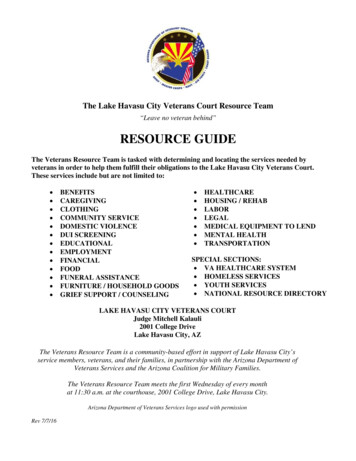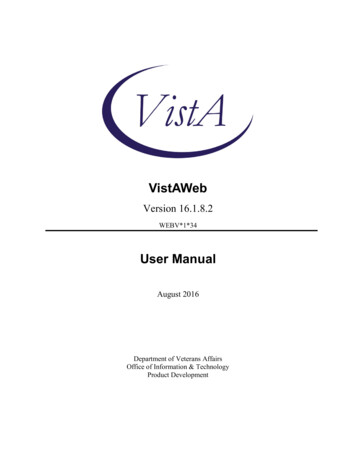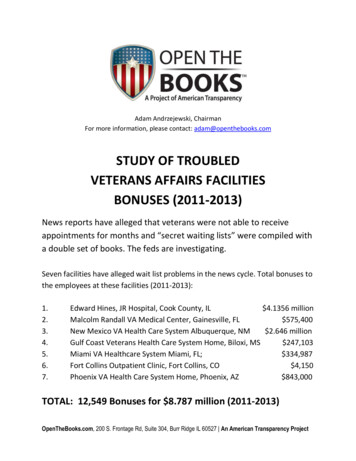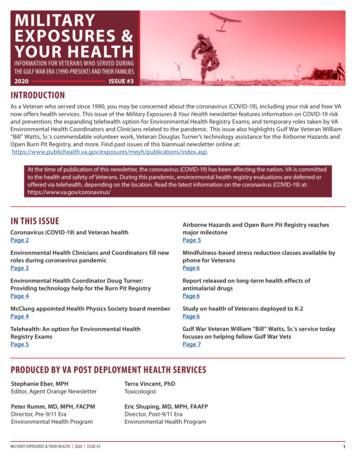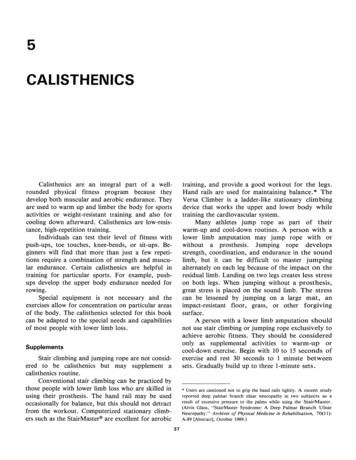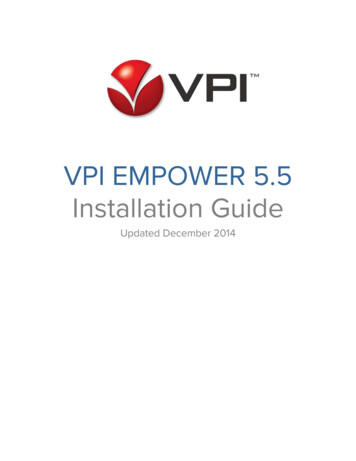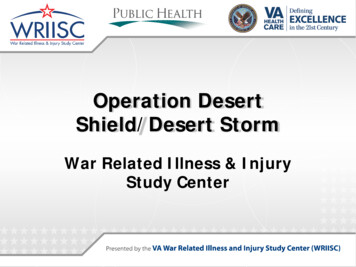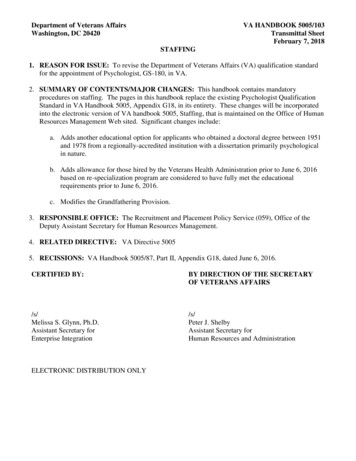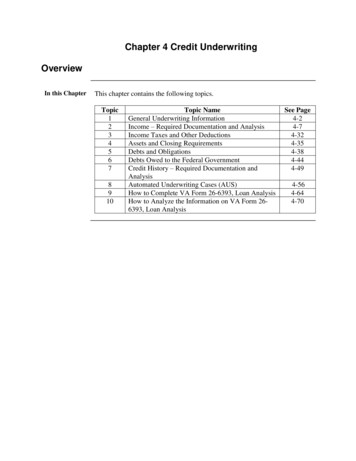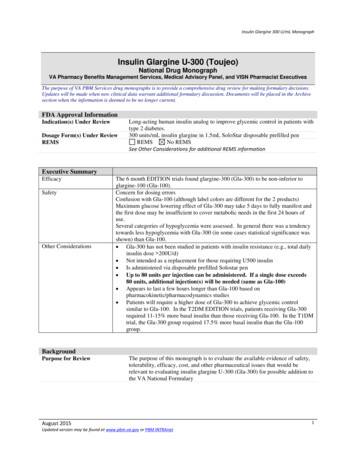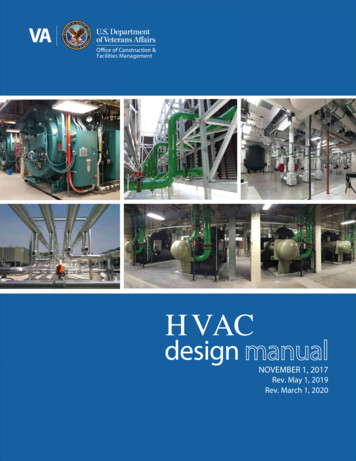
Transcription
Facilities ManagementHVACdesignNOVEMBER 1, 2017Rev. May 1, 2019Rev. March 1, 2020
HVAC Design ManualNovember 1, 2017TABLE OF CONTENTSChapter 1: BASIC REQUIREMENTS1.1GENERAL . 1-21.2ENERGY CONSERVATION . 1-31.3MEASUREMENT AND VERIFICATION. 1-41.4ABBREVIATIONS AND REFERENCES. 1-41.5COMMISSIONING . 1-41.6VA STANDARDS . 1-41.7HVAC DESIGN MANUAL (PG 18-10) ANDA/E SUBMISSION REQUIREMENTS (PG 18-15) . 1-131.8VA HOSPITAL BUILDING SYSTEM . 1-14APPENDIX 1-A: VA HOSPITAL BUILDING SYSTEM. 1-151-A.1DESCRIPTION OF MODULES . 1-151-A.2REFERENCES . 1-161-A.3BASIC DESIGN OF A SERVICE ZONE . 1-16Chapter 2: HVAC DESIGN PARAMETERS AND SELECTION CRITERIA2.1GENERAL . 2-22.2BASIS OF DESIGN . 2-22.3SPECIAL STUDIES . 2-82.4BUILDING THERMAL ENVELOPE (EXISTING FACILITIES ONLY) . 2-102.5VIBRATION CONTROL . 2-102.6SEISMIC DESIGN REQUIREMENTS . 2-112.7FIRE AND SMOKE PROTECTION. 2-122.8DESIGN CONSIDERATIONS FOR EXISTING BUILDINGS . 2-132.9PROJECT PLANNING . 2-152.10DEMOLITION WORK . 2-162.11LOCATIONS OF OUTDOOR AIR INTAKES AND EXHAUST AIR OUTLETS . 2-16Chapter 3: AIRSIDE HVAC SYSTEMS AND EQUIPMENT3.1INTRODUCTION . 3-33.2ALL-AIR SYSTEMS . 3-33.3TERMINAL COOLING AND HEATING SYSTEMS . 3-13GENERALi
HVAC Design ManualNovember 1, 20173.4HEATING AND VENTILATION UNITS (HVU) . 3-153.5SUPPLY AIR OUTLETS . 3-163.6ENERGY RECOVERY SYSTEMS. 3-173.7DESIGN CRITERIA – AIR DISTRIBUTION SYSTEMS . 3-193.8EXHAUST SYSTEMS. 3-223.9LABORATORIES AND ANIMAL FACILITIES. 3-243.10FUME HOOD EXHAUST SYSTEMS. 3-273.11BIOLOGICAL SAFETY CABINETS (BSC) . 3-313.12BIOLOGICAL SAFETY LEVEL 3 (BSL3) . 3-34APPENDIX 3-A: BIO-SAFETY LEVEL 3 (BSL3) FACILITIES . 3-373-A.1GENERAL . 3-373-A.2PRIMARY BARRIERS . 3-373-A.3SECONDARY BARRIERS . 3-373-A.4PLUMBING AND FIRE PROTECTION CONSIDERATIONS . 3-38Chapter 4: BUILDING COOLING AND HEATING SYSTEM4.1INTRODUCTION . 4-24.2COOLING SYSTEMS – CHILLED WATER . 4-24.3COOLING SYSTEMS - DIRECT EXPANSION (DX) . 4-124.4HEATING SYSTEMS . 4-134.5DESIGN CRITERIA – PIPING SYSTEMS . 4-21APPENDIX 4-A: PROPYLENE GLYCOL – WATER SOLUTION. 4-294-A.1GENERAL . 4-294-A.2PUMP SELECTION . 4-314-A.3SAMPLE PUMP SELECTION – WITH PROPYLENE GLYCOL SOLUTION . 4-324-A.4NOTES TO BE ADDED TO EQUIPMENT SCHEDULES . 4-35Chapter 5: HVAC CONTROL SYSTEMS5.1GENERAL . 5-25.2BASIC DESIGN NEW STANDALONE FACILITY . 5-45.3BACNET CONTROLLER IDENTIFICATION . 5-55.4BASIC DESIGN ALL PROJECTS INTEGRATING TO EXISTING DDC SYSTEMS . 5-55.5SPECIFIC REQUIREMENTS . 5-65.6HUMIDITY SENSORS . 5-11GENERALii
HVAC Design ManualNovember 1, 20175.7SYSTEM APPLICATIONS . 5-115.8SUSTAINABILITY AND MAINTAINABILITY PRACTICES . 5-155.9DOCUMENTATION REQUIREMENTS . 5-16Chapter 6: APPLICATIONS6.1OVERVIEW. 6-56.2DEDICATED AIR-HANDLING UNITS . 6-56.3COMMON (NON-DEDICATED) AIR-HANDLING UNITS. 6-66.4GENERAL NOTES . 6-7DEDICATED AHU SYSTEM DATA SHEETS AND ROOM DATA SHEETS. 6-13All Chapter 6 System and Room Data in Excel (Section 508 compliant)Chapter 7: CLIMATIC DATA7.1CLIMATIC CONDITIONS . 7-27.2HIGH HUMIDITY LOCATIONS. 7-197.3LOW HUMIDITY LOCATIONS . 7-20Chapter 8: ABBREVIATIONS AND REFERENCES8.1ABBREVIATIONS . 8-28.2REFERENCES . 8-8GENERALiii
HVAC Design ManualNovember 1, 2017FOREWORDVA Program Offices, project teams, designers and constructors, are obligated to our Nation'sVeterans and taxpayers to make the most effective and efficient use of resources, by providinga continuum of safe, secure, high quality, high performance, and high value environments ofcare and service for Veterans. The VA Office of Construction and Facilities Management (CFM)supports the Department's mission through development and application of standards as abasis for disciplined planning, design, and construction of VA facilities.VA Standards are the culmination of a partnership among the Department of Veterans Affairs(VA), the VA Administrations, Program Officials, Clinicians, Industry, Academic and ResearchOrganizations, Expert Consultants, and the Office of Construction and Facilities Management.VA Standards are developed through integration of VA-specific requirements, Federal law andregulation, benchmarking of industry best practice, evidence-based research and design, andvalue-based analysis of leading edge innovation. The result is the establishment of best valuestandards for optimum functionality, safety, operability, performance, and quality throughoutthe VA environment of care and service.The VA Technical Information Library (TIL) (www.cfm.va.gov/TIL) provides standards for all VAplanning, design, and construction projects. VA TIL Standards communicate the basis of designand are required to be utilized by project teams working on new construction and renovationsof existing facilities. VA Standards will maximize the effectiveness and efficiency of theplanning and design process and facilitate a high level of design, while controlling construction,operating, and maintenance costs.For all VA projects, it is required that project teams comply with the following in all phases ofproject development:1) All applicable VA Standards published in the VA Technical Information Library (TIL) shallbe applied as a basis, foundation, and framework in planning, design, and construction.Any substantial variance from Standards shall be considered only as required toaccommodate specific site, functional, and operational conditions. Upon considerationof variance CFM shall be consulted, and each Administration will function as AuthorityHaving Jurisdiction for decision. Each substantial variance shall have a basis rationaleand be documented in the project record;2) Clinicians, providers, primary users, and other stakeholders shall be involved in allphases of project development to best adapt Standards for specific functional,operational, and site conditions, and to provide optimum service environments forVeterans. This also includes installations and modifications of systems or technologyinvolving safety, security, functionality, or environmental quality. Stakeholderinvolvement shall be documented in the project record.VA TIL Standards are not project‐specific. It is impossible to foresee all rapidly evolvingrequirements of VA facilities and each site or project will have unique requirements orconditions. Site‐specific issues must be addressed within the context of these standards andapplied to each individual project. Use these Standards does not preclude the need for, norabsolve planners, designers, and constructors of their responsibility to provide complete,GENERALiv
HVAC Design ManualNovember 1, 2017functional, safe, and secure designs suited to the unique requirements of each project, withinbudget, and on schedule.Materials, equipment and systems are shown in an illustrative, performance-based format andare not intended to depict, suggest, or otherwise constitute endorsement of any specificproduct or manufacturer. Manufacturers should be consulted for actual dimensions,configurations, and utility requirements.For additional information regarding the VA Technical Information Library and developmentand application of VA planning, design, and construction standards, please contact Donald L.Myers, Director, Facilities Standards Service, US Department of Veterans Affairs, Office ofConstruction and Facilities Management.GENERALv
HVAC Design ManualNovember 1, 2017ACKNOWLEDGEMENTSThe following individuals are those whose guidance, insight, advice and expertise made theupdate and revision of the HVAC Design Manual possi
All Chapter 6 System and Room Data in Excel (Section 508 compliant) Chapter 7: CLIMATIC DATA . 7.1 CLIMATIC CONDITIONS . 7-2 . 7.2 HIGH HUMIDITY LOCATIONS . 7-19 . 7.3 LOW HUMIDITY LOCATIONS . 7-20 . Chapter 8: ABBREVIATIONS AND REFERENCES . 8.1 ABBREVIATIONS . 8-2 . 8.2 REFERENCES . 8-8 . HVAC Design Manual November 1, 2017 . GENERAL iv .
